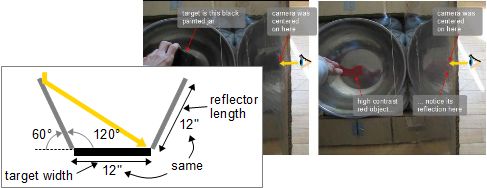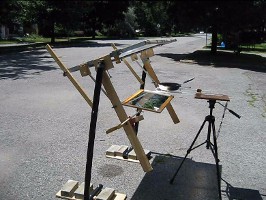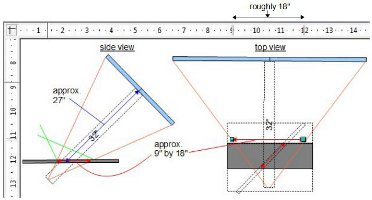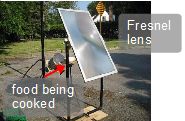Many solar cookers can be made without much design at all.
It's amazing what a few reflective surfaces or a bit of black
paint can do with bright sunlight. This page will evolve to
show a bunch of design tips should you need them as I learn more.
Capturing the sunlight
The capture area is the area of
sunlight that you'll be capturing. There are many misconceptions
about capturing sunlight, especially when it comes to reflectors,
and often brought on by thinking of sunlight as a fluid such as water.
See this page on
designing your capture area for more.
Designing reflectors for solar cookers
The whole purpose of reflectors in a solar cooker is to capture
a large area of sunlight and direct it all down to where it can
be converted to heat. Improperly designed reflectors will
reflect some of that sunlight right back away. This page
on
how to design reflectors for a solar cooker will show
you how to make sure the sunlight goes to where you need it.
How I designed a fresnel lens and mirror solar cooker
Normally a fresnel lens sends sunlight down to a cooking pot.
This results in a very bright light to look down on that requires
welding goggles to look at. I wanted an arrangement where the
light would shine up to the bottom of the pot so that no goggles
would be needed. This page is all about
how I
designed my fresnel lens and mirror solar cooker.
How a Fresnel lens doesn't help a box solar cooker
For those who don't know, a Fresnel lens is very simply, a large
lens that focuses sunlight to a spot, concentrating it.
It's the same thing as a magnifying glass except that it's made
to be flat like a sheet of glass. Though it's not really flat,
it has tiny grooves on its surface. You can learn all about Fresnel
lenses on my
Fresnel lens page.
I've been asked if using a Fresnel lens would work better instead
of the glass in a box type solar cooker and the answer is no,
it won't help. In the diagram below are a box cooker with a glass
and one with a Fresnel lens. On the far right is a illustration of
how the light bends as it enters and leaves the lens.
There are two main points to realize. The first is that the amount of
sunlight entering the solar cooker is the same in both cases, 432
square inches. That's called the
capture area.
The second point is that all the sunlight that passes through the lens,
or the glass, enters the box. Once it enters the box, the majority of
it gets converted to heat when it strikes a surface. Only a little of the
light leaves the box again. The hot surfaces heat the air, which
heats the cooking pot and cooks the food. A solar box cooker is one
that primarily cooks like a normal kitchen oven, by first heating the
air in the oven. So there's no advantage to using a Fresnel lens
with a box solar cooker.






